Solar eclipse of May 21, 2031
| Solar eclipse of May 21, 2031 | |
|---|---|
| Type of eclipse | |
| Nature | Annular |
| Gamma | −0.197 |
| Magnitude | 0.9589 |
| Maximum eclipse | |
| Duration | 326 s (5 min 26 s) |
| Coordinates | 8°54′N 71°42′E / 8.9°N 71.7°E |
| Max. width of band | 152 km (94 mi) |
| Times (UTC) | |
| Greatest eclipse | 7:16:04 |
| References | |
| Saros | 138 (32 of 70) |
| Catalog # (SE5000) | 9577 |
An annular solar eclipse will occur at the Moon's descending node of orbit on Wednesday, May 21, 2031,[1] with a magnitude of 0.9589. A solar eclipse occurs when the Moon passes between Earth and the Sun, thereby totally or partly obscuring the image of the Sun for a viewer on Earth. An annular solar eclipse occurs when the Moon's apparent diameter is smaller than the Sun's, blocking most of the Sun's light and causing the Sun to look like an annulus (ring). An annular eclipse appears as a partial eclipse over a region of the Earth thousands of kilometres wide. Occurring about 3.8 days before apogee (on May 25, 2031, at 3:10 UTC), the Moon's apparent diameter will be smaller.[2]
Annularity will be visible from parts of Angola, Zambia, the southern Democratic Republic of the Congo, northern Malawi, Tanzania, southern India, northern Sri Lanka, the Andaman and Nicobar Islands, southern Thailand, Malaysia, and much of Indonesia. A partial eclipse will be visible for much of Africa, the Middle East, South Asia, Southeast Asia, and Australia.
Images
[edit]Eclipse details
[edit]Shown below are two tables displaying details about this particular solar eclipse. The first table outlines times at which the moon's penumbra or umbra attains the specific parameter, and the second table describes various other parameters pertaining to this eclipse.[3]
| Event | Time (UTC) |
|---|---|
| First Penumbral External Contact | 2031 May 21 at 04:15:23.0 UTC |
| First Umbral External Contact | 2031 May 21 at 05:19:52.6 UTC |
| First Central Line | 2031 May 21 at 05:21:47.0 UTC |
| First Umbral Internal Contact | 2031 May 21 at 05:23:41.5 UTC |
| First Penumbral Internal Contact | 2031 May 21 at 06:30:37.3 UTC |
| Equatorial Conjunction | 2031 May 21 at 07:13:28.3 UTC |
| Greatest Eclipse | 2031 May 21 at 07:16:04.3 UTC |
| Ecliptic Conjunction | 2031 May 21 at 07:18:22.9 UTC |
| Greatest Duration | 2031 May 21 at 07:24:28.7 UTC |
| Last Penumbral Internal Contact | 2031 May 21 at 08:01:34.7 UTC |
| Last Umbral Internal Contact | 2031 May 21 at 09:08:27.6 UTC |
| Last Central Line | 2031 May 21 at 09:10:24.0 UTC |
| Last Umbral External Contact | 2031 May 21 at 09:12:20.5 UTC |
| Last Penumbral External Contact | 2031 May 21 at 10:16:51.4 UTC |
| Parameter | Value |
|---|---|
| Eclipse Magnitude | 0.95892 |
| Eclipse Obscuration | 0.91954 |
| Gamma | −0.19699 |
| Sun Right Ascension | 03h51m34.6s |
| Sun Declination | +20°09'39.2" |
| Sun Semi-Diameter | 15'48.2" |
| Sun Equatorial Horizontal Parallax | 08.7" |
| Moon Right Ascension | 03h51m39.8s |
| Moon Declination | +19°58'57.5" |
| Moon Semi-Diameter | 14'55.8" |
| Moon Equatorial Horizontal Parallax | 0°54'47.5" |
| ΔT | 74.4 s |
Stars and Planets during the Eclipse
[edit]Even those stars and planets bright enough to be visible during a total solar eclipse are in most cases not visible during an annular eclipse. The best candidate for naked-eye sighting is Venus, although it will be many degrees east of the Sun and therefore below the eastern horizon for morning observers in Africa. In southern India it will be well up in the east but at a lower altitude than the Sun. Venus will be best seen in those areas such as Malaysia and Indonesia where the eclipse peaks near sunset; it will be high in the west.
If any star is spotted during the eclipse it will be Sirius, which will be high in the east-southeast for observers in India and high in the west-southwest for observers in the East Indies.
Eclipse season
[edit]This eclipse is part of an eclipse season, a period, roughly every six months, when eclipses occur. Only two (or occasionally three) eclipse seasons occur each year, and each season lasts about 35 days and repeats just short of six months (173 days) later; thus two full eclipse seasons always occur each year. Either two or three eclipses happen each eclipse season. In the sequence below, each eclipse is separated by a fortnight. The first and last eclipse in this sequence is separated by one synodic month.
| May 7 Ascending node (full moon) |
May 21 Descending node (new moon) |
June 5 Ascending node (full moon) |
|---|---|---|
 |
 |

|
| Penumbral lunar eclipse Lunar Saros 112 |
Annular solar eclipse Solar Saros 138 |
Penumbral lunar eclipse Lunar Saros 150 |
Related eclipses
[edit]Eclipses in 2031
[edit]- A penumbral lunar eclipse on May 7.
- An annular solar eclipse on May 21.
- A penumbral lunar eclipse on June 5.
- A penumbral lunar eclipse on October 30.
- A hybrid solar eclipse on November 14.
Metonic
[edit]- Preceded by: Solar eclipse of August 2, 2027
- Followed by: Solar eclipse of March 9, 2035
Tzolkinex
[edit]- Preceded by: Solar eclipse of April 8, 2024
- Followed by: Solar eclipse of July 2, 2038
Half-Saros
[edit]- Preceded by: Lunar eclipse of May 16, 2022
- Followed by: Lunar eclipse of May 26, 2040
Tritos
[edit]- Preceded by: Solar eclipse of June 21, 2020
- Followed by: Solar eclipse of April 20, 2042
Solar Saros 138
[edit]- Preceded by: Solar eclipse of May 10, 2013
- Followed by: Solar eclipse of May 31, 2049
Inex
[edit]- Preceded by: Solar eclipse of June 10, 2002
- Followed by: Solar eclipse of April 30, 2060
Triad
[edit]- Preceded by: Solar eclipse of July 20, 1944
- Followed by: Solar eclipse of March 22, 2118
Solar eclipses of 2029–2032
[edit]This eclipse is a member of a semester series. An eclipse in a semester series of solar eclipses repeats approximately every 177 days and 4 hours (a semester) at alternating nodes of the Moon's orbit.[4]
The partial solar eclipses on January 14, 2029 and July 11, 2029 occur in the previous lunar year eclipse set.
| Solar eclipse series sets from 2029 to 2032 | ||||||
|---|---|---|---|---|---|---|
| Descending node | Ascending node | |||||
| Saros | Map | Gamma | Saros | Map | Gamma | |
| 118 | June 12, 2029 Partial |
1.29431 | 123 | December 5, 2029 Partial |
−1.06090 | |
| 128 | June 1, 2030 Annular |
0.56265 | 133 | November 25, 2030 Total |
−0.38669 | |
| 138 | May 21, 2031 Annular |
−0.19699 | 143 | November 14, 2031 Hybrid |
0.30776 | |
| 148 | May 9, 2032 Annular |
−0.93748 | 153 | November 3, 2032 Partial |
1.06431 | |
Saros 138
[edit]This eclipse is a part of Saros series 138, repeating every 18 years, 11 days, and containing 70 events. The series started with a partial solar eclipse on June 6, 1472. It contains annular eclipses from August 31, 1598 through February 18, 2482; a hybrid eclipse on March 1, 2500; and total eclipses from March 12, 2518 through April 3, 2554. The series ends at member 70 as a partial eclipse on July 11, 2716. Its eclipses are tabulated in three columns; every third eclipse in the same column is one exeligmos apart, so they all cast shadows over approximately the same parts of the Earth.
The longest duration of annularity was produced by member 23 at 8 minutes, 2 seconds on February 11, 1869, and the longest duration of totality will be produced by member 61 at 56 seconds on April 3, 2554. All eclipses in this series occur at the Moon’s descending node of orbit.[5]
| Series members 20–41 occur between 1801 and 2200: | ||
|---|---|---|
| 20 | 21 | 22 |
 January 10, 1815 |
 January 20, 1833 |
 February 1, 1851 |
| 23 | 24 | 25 |
 February 11, 1869 |
 February 22, 1887 |
 March 6, 1905 |
| 26 | 27 | 28 |
 March 17, 1923 |
 March 27, 1941 |
 April 8, 1959 |
| 29 | 30 | 31 |
 April 18, 1977 |
 April 29, 1995 |
 May 10, 2013 |
| 32 | 33 | 34 |
 May 21, 2031 |
 May 31, 2049 |
 June 11, 2067 |
| 35 | 36 | 37 |
 June 22, 2085 |
 July 4, 2103 |
 July 14, 2121 |
| 38 | 39 | 40 |
 July 25, 2139 |
 August 5, 2157 |
 August 16, 2175 |
| 41 | ||
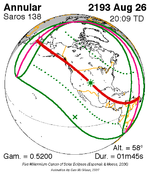 August 26, 2193 | ||
Metonic series
[edit]The metonic series repeats eclipses every 19 years (6939.69 days), lasting about 5 cycles. Eclipses occur in nearly the same calendar date. In addition, the octon subseries repeats 1/5 of that or every 3.8 years (1387.94 days). All eclipses in this table occur at the Moon's descending node.
| 21 eclipse events between May 21, 1993 and May 20, 2069 | ||||
|---|---|---|---|---|
| May 20–21 | March 9 | December 25–26 | October 13–14 | August 1–2 |
| 118 | 120 | 122 | 124 | 126 |
 May 21, 1993 |
 March 9, 1997 |
 December 25, 2000 |
 October 14, 2004 |
 August 1, 2008 |
| 128 | 130 | 132 | 134 | 136 |
 May 20, 2012 |
 March 9, 2016 |
 December 26, 2019 |
 October 14, 2023 |
 August 2, 2027 |
| 138 | 140 | 142 | 144 | 146 |
 May 21, 2031 |
 March 9, 2035 |
 December 26, 2038 |
 October 14, 2042 |
 August 2, 2046 |
| 148 | 150 | 152 | 154 | 156 |
 May 20, 2050 |
 March 9, 2054 |
 December 26, 2057 |
 October 13, 2061 |
 August 2, 2065 |
| 158 | ||||
 May 20, 2069 | ||||
Tritos series
[edit]This eclipse is a part of a tritos cycle, repeating at alternating nodes every 135 synodic months (≈ 3986.63 days, or 11 years minus 1 month). Their appearance and longitude are irregular due to a lack of synchronization with the anomalistic month (period of perigee), but groupings of 3 tritos cycles (≈ 33 years minus 3 months) come close (≈ 434.044 anomalistic months), so eclipses are similar in these groupings.
| Series members between 1801 and 2200 | ||||
|---|---|---|---|---|
 March 4, 1802 (Saros 117) |
 February 1, 1813 (Saros 118) |
 January 1, 1824 (Saros 119) |
 November 30, 1834 (Saros 120) |
 October 30, 1845 (Saros 121) |
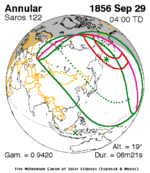 September 29, 1856 (Saros 122) |
 August 29, 1867 (Saros 123) |
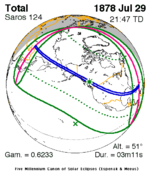 July 29, 1878 (Saros 124) |
 June 28, 1889 (Saros 125) |
 May 28, 1900 (Saros 126) |
 April 28, 1911 (Saros 127) |
 March 28, 1922 (Saros 128) |
 February 24, 1933 (Saros 129) |
 January 25, 1944 (Saros 130) |
 December 25, 1954 (Saros 131) |
 November 23, 1965 (Saros 132) |
 October 23, 1976 (Saros 133) |
 September 23, 1987 (Saros 134) |
 August 22, 1998 (Saros 135) |
 July 22, 2009 (Saros 136) |
 June 21, 2020 (Saros 137) |
 May 21, 2031 (Saros 138) |
 April 20, 2042 (Saros 139) |
 March 20, 2053 (Saros 140) |
 February 17, 2064 (Saros 141) |
 January 16, 2075 (Saros 142) |
 December 16, 2085 (Saros 143) |
 November 15, 2096 (Saros 144) |
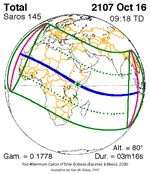 October 16, 2107 (Saros 145) |
 September 15, 2118 (Saros 146) |
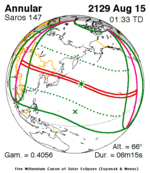 August 15, 2129 (Saros 147) |
 July 14, 2140 (Saros 148) |
 June 14, 2151 (Saros 149) |
 May 14, 2162 (Saros 150) |
 April 12, 2173 (Saros 151) |
 March 12, 2184 (Saros 152) |
 February 10, 2195 (Saros 153) | |||
Inex series
[edit]This eclipse is a part of the long period inex cycle, repeating at alternating nodes, every 358 synodic months (≈ 10,571.95 days, or 29 years minus 20 days). Their appearance and longitude are irregular due to a lack of synchronization with the anomalistic month (period of perigee). However, groupings of 3 inex cycles (≈ 87 years minus 2 months) comes close (≈ 1,151.02 anomalistic months), so eclipses are similar in these groupings.
| Series members between 1801 and 2200 | ||
|---|---|---|
 October 9, 1828 (Saros 131) |
 September 18, 1857 (Saros 132) |
 August 29, 1886 (Saros 133) |
 August 10, 1915 (Saros 134) |
 July 20, 1944 (Saros 135) |
 June 30, 1973 (Saros 136) |
 June 10, 2002 (Saros 137) |
 May 21, 2031 (Saros 138) |
 April 30, 2060 (Saros 139) |
 April 10, 2089 (Saros 140) |
 March 22, 2118 (Saros 141) |
 March 2, 2147 (Saros 142) |
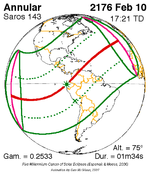 February 10, 2176 (Saros 143) |
||
References
[edit]- ^ "May 21, 2031 Annular Solar Eclipse". timeanddate. Retrieved 14 August 2024.
- ^ "Moon Distances for London, United Kingdom, England". timeanddate. Retrieved 14 August 2024.
- ^ "Annular Solar Eclipse of 2031 May 21". EclipseWise.com. Retrieved 14 August 2024.
- ^ van Gent, R.H. "Solar- and Lunar-Eclipse Predictions from Antiquity to the Present". A Catalogue of Eclipse Cycles. Utrecht University. Retrieved 6 October 2018.
- ^ "NASA - Catalog of Solar Eclipses of Saros 138". eclipse.gsfc.nasa.gov.





